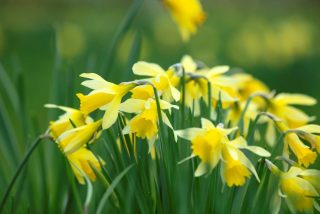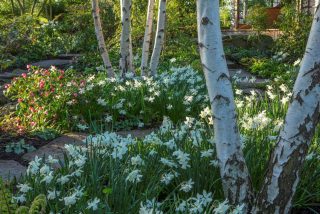A Golden Spring
As we look forward to welcoming back the first visitors to Morton Hall for over a year, there is one flower that symbolises the hope and excitement of the garden team for this moment and the year ahead, the humble Daffodil. Its cheerful, nodding yellow flowers are synonymous with spring and it is one of the most popular cut flowers in the UK, with the UK responsible for 90% of the total daffodil flower production worldwide.

However, this most characteristic of spring flowers which is also the national flower of Wales, is not as British as you might think! In fact, the majority of daffodil species can be found on the Iberian Peninsula and out of the over 150 daffodil species, just one, Narcissus pseudonarcissus, is naturalised across the UK. It is thought that the daffodil was brought over to the UK by the Romans, or perhaps was genuinely native, but disappeared after the ice age and was reintroduced afterwards. Whatever the true story, daffodils are an extremely complex group of plants and can hybridise readily with one another, with more than 15,000 named varieties in cultivation.

The botanical name for daffodil is thought to have been inspired by Narcissus, a figure in Greek mythology who fell in love with his reflection in a pool of water. The nodding head of the daffodil is said to represent Narcissus gazing at his reflection. It is perhaps then rather appropriate that Narcissus ‘Thalia’ is planted around the pond in the Stroll Garden with its pale nodding flowers reflecting in the tranquil water as they appear in April.

Due to their complexity, daffodils can be split into several different horticultural groups based on their flower characteristics, known as ‘Divisions’. There are 13 different divisions with the individual divisions for each cultivar denoted by a number after their name. Here at Morton Hall, we grow many different cultivars including Narcissus ‘Peeping Tom’ with its characteristic swept-back petals giving this small-flowered daffodil a somewhat ‘windswept’ look. Narcissus ‘Cragford’ is another favourite. Grown in the meadow, this variety was introduced into cultivation before 1930 and produces a cluster of flowers on each stem with each scented flower exhibiting a distinct orange-red cup.

Daffodils provided material for some of the very first understanding about plant hybridisation however this has led to some debate amongst botanists as to what is a ‘true species’ and what is a natural ‘ancient’ hybrid. One such example can be found growing in the ancient woodland here at Morton Hall. First described in 1629 by botanist John Parkinson, Narcissus pseudonarcissus anglicus flore pleno is a very rare form of the wild daffodil with double flowers often given the common name Gerrard’s Double Daffodil after Parkinson’s friend John Gerard. This very special daffodil was once thought to be wild, but in 1933 botanist Herbert William Pugsley hypothesised that this daffodil, along with several other naturalised double-flowered daffodils were relics of former cultivated varieties imported from France and the Netherlands. Now known more simply as Narcissus pseudonarcissus ‘Plenus’, most double flowered daffodils are sterile meaning they produce no viable seed so spread by producing bulb-offsets from the parent bulb underground over many years. How this daffodil came to be in the woodland at Morton Hall remains a mystery!
